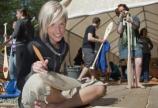A vehicle for Indigenous learning & teaching
- Crystal Bergeron

In the Faculty of Education, teaching and learning go hand in hand, but not always in traditional classrooms. In its efforts to celebrate Indigenous ways of learning and teaching and incorporate them into UVic’s teacher education programs, the Faculty of Education continues to push the envelope when it comes to innovative ways to learn.
One example is the extremely popular course EDCI 499: Learning and Teaching in an Indigenous World, an innovative course series pedagogically based on Indigenous teaching and learning experiences. Currently, the sixth installment of the series, “CÁ E TTE SNEWEL” or “Working on the canoe,” is under way in First Peoples House. The “canoe course” as it’s known on campus, provides insight into Indigenous pedagogy by leading learners down a path of respectful practice, community engagement and personal responsibility.
Under the tutelage of UVic instructor Nick Claxton, W’SANEC carver Perry LaFortune and local Indigenous knowledge keepers, students are investigating and experiencing the Straits Salish culture, language and ways of life through active participation in the creation of a traditional W’SANEC dugout canoe and individual paddles.
“This course is a living example of how Indigenous knowledge can be successfully included at a major university alongside more traditional European teaching methods,” says Prof. Onowa McIvor, director of Indigenous education. “Students are loving this course and learning experientially by doing, through observation, listening and sharing.”
Drop by the class and you will feel the contagious energy under the carving tent alongside First Peoples House. Here, you will find students proudly working together with instructors, elders and family members of the carvers. The sense of community is obvious.
“EDCI 499 is more than carving a canoe,” explains Claxton. “It’s not just a piece of wood; it’s not just a tree; to us, it’s a relative.” Students couldn’t agree more.
In her final project video, teacher education student Kim Wilkinson expressed her enthusiasm for the course: “You get the best of both worlds and the opportunity to see through a different lens. Experiential learning stays with you forever.”
Head carver Perry LaFortune has found his first university teaching experience to be transformative in every way. He’s excited about the relationships he has formed with the students and they with each other. “Some things you just can’t teach on a board,” says LaFortune. “You have to learn by doing. If these students can take what they have learned about Indigenous knowledge into their future classrooms, we’ll have better success with the students of tomorrow.”
“This rather extraordinary course has given our students a truly unique opportunity to witness, experience and actually contribute to the carving of the canoe,” says Dr. Alison Preece, associate dean of teacher education. “While immersed in carving their own paddles, observing the carvers and engaging with members of the local First Nations communities, they’ve gained insights into all that the canoe means and represents culturally that runs so much deeper than simply ‘being told’ about it. They’ve lived a way of teaching and learning that, for many, will enrich and shift their understanding of what teaching and learning can be.”
For more information on courses in the EDCI 499 series, contact Indigenous Education at 250-721-7826 or via email at ied@uvic.ca. This course is open to all UVic students.


